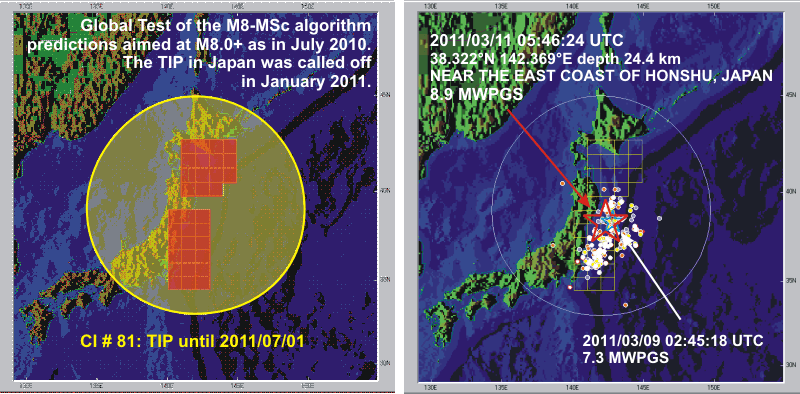

|
A cluster of "false alarm" TIP's in Japan lasted from the middle of 2001 to the end of 2010 gradually migrating from southwestern to the northern regions: It started with CI #64, expanded in 2006 to CIs #82 then #80; in 2007 #64 was called off and ##80-82 formed a new area of alarm, which has shrunk to a single #81 in January 2010. The alarm can be associated with the failures-to-predict the great 25/09/2003 M8.3, 15/11/2006 M8.3, and 13/01/2007 M8.2 earthquake, each of which were linked by the RTP chains of correlated quakes (Keilis-Borok et al., 2004; Shebalin et al., 2006) to the M8-MSc prediction areas, as well as to a series of earthquakes started with the 2002/06/28 M7.3 deep event (depth 566 km) near Priamurye-Northeastern China border in the back of and outside the alerted section of subduction zone, followed by twelve shallow magnitude 7.0 or larger earthquakes in the area alerted in 2002-2010, and ended with the 09/08/2009 M7.1 deep earthquake (depth 292 km) beneath Izu Islands. The Tokai silent earthquake initiated in 2001 and lasted for many years in the middle of this cluster of "false alarm" could be also physically related phenomenon. Finally, the mega-thrust on 11 March 2011 completed the peculiar history of the "false alarm" in Japan on the 70th day after it was formally called off (see figure above). Its first aftershocks (white dots) spread along the entire patch of the M8-MSc prediction outline. The M7.3 earthquake on 9 March 2011 preceded the mega-shock by 51 hours and, according to Takeshi Kudo (personal communication), was a suspect foreshock of the expected by Japanese seismologists "M7.5 class Miyagi-Ken-Oki earthquake". The premature termination of TIP in the 2011a Update of the Global Test of M8-MSc predictions happen to be due to the function Z1 (an inverse of the Zhurkov criterion, which is linear concentration of ruptures) anomaly threshold change from 2407 to 2440 bringing the voting scores from the required (and factual in the 2010b Update) 4:6/4:6 down to 4:6/4:5... A reasonable man would not even notice this change in one of the seven graphs involved in TIP diagnosis, while the prefixed in 1992 "black box" version of the M8 algorithm does. It is hard to disagree with Prof. Keilis-Borok saying: "The alarm, its premature termination notwithstanding, could have been used for damage reduction." The magnitude of the 2011 off the Pacific coast of Tohoku Earthquake might be larger than 8.9 (preliminary Global CMT estimate is 9.1 waiting for longer period records). On the other hand, unlike the 26 December 2004 mega-thrust, the rupture in Sendai earthquake is surprisingly limited to about 400 km. This compactness may explain why its precursory patterns were not recognized by M8 aimed at M9.0+, but were diagnosed in advance the 2010 Chile mega-thrust with about 600 km of rupture. The current alarm for M8.5+ in Japan was not terminated in January, however, the M9.0+ and M8.5+ ranges are outside the scope of Global Test of the M8-MSc predictions and could not be considered as documented in advance the 11 March 2011 mega-thrust. |
|
Back to "List of predictions" |